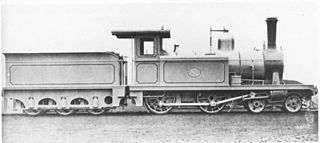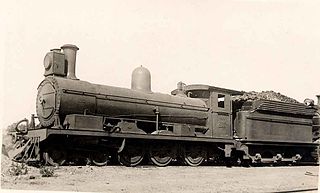
The South African Railways Class 8 4-8-0 of 1902 was a steam locomotive from the pre-Union era in the Cape of Good Hope.

The South African Railways Class 8D 4-8-0 of 1903 was a steam locomotive from the pre-Union era in the Cape of Good Hope.

The Cape Government Railways 2nd Class 2-6-2TT of 1875 was a South African steam locomotive from the pre-Union era in the Cape of Good Hope.

The Cape Government Railways 1st Class 4-4-0T of 1875 was a South African steam locomotive from the pre-Union era in the Cape of Good Hope.

The Cape Government Railways 1st Class 4-4-0TT of 1881 was a South African steam locomotive from the pre-Union era in the Cape of Good Hope.

The Cape Government Railways 1st Class 4-4-0 of 1879 was a South African steam locomotive from the pre-Union era in the Cape of Good Hope.

The Cape Government Railways 3rd Class 4-4-0 of 1884 was a South African steam locomotive from the pre-Union era in the Cape of Good Hope.

The Cape Government Railways 4th Class 4-6-0TT of 1882 was a South African steam locomotive from the pre-Union era in the Cape of Good Hope.

The Cape Government Railways 4th Class 4-6-0TT of 1884 was a South African steam locomotive from the pre-Union era in the Cape of Good Hope.

The Cape Government Railways 5th Class 4-6-0 of 1890 was a South African steam locomotive from the pre-Union era in the Cape of Good Hope.

The Cape Government Railways 5th Class 4-6-0 of 1891 was a South African steam locomotive from the pre-Union era in the Cape of Good Hope.

The Cape Government Railways 1st Class 0-4-0ST of 1875 was a South African steam locomotive from the pre-Union era in the Cape of Good Hope.

The Cape Government Railways 1st Class 2-6-0 of 1876 by Kitson was a South African steam locomotive from the pre-Union era in the Cape of Good Hope.

The Cape Government Railways 4th Class locomotives include five locomotive types, all designated 4th Class irrespective of differences in wheel arrangement or configuration.
The South African type ZB tender was a steam locomotive tender from the pre-Union era in the Cape of Good Hope.

The South African type ZA tender was a steam locomotive tender from the pre-Union era in the Cape of Good Hope.

South African steam locomotive tenders were classified by means of type letters and sometimes numbers, while locomotive specifications included a list of permissible tenders which could be used with each engine class.

The South African type YE1 tender was a steam locomotive tender from the pre-Union era in the Cape of Good Hope.
The Cape Government Railways 4th Class 4-6-0TT of 1882 with Joy valve gear, was a South African steam locomotive from the pre-Union era in the Cape of Good Hope.

John D. Tilney was Cape Government Railways Locomotive Superintendent (1874-1904).























